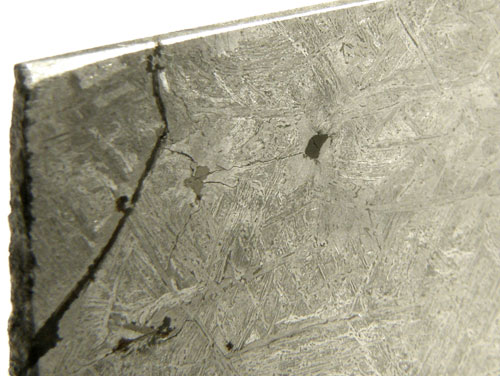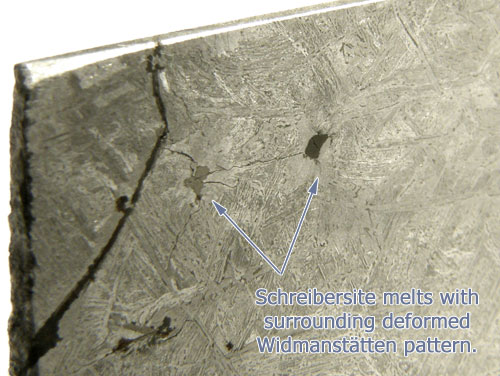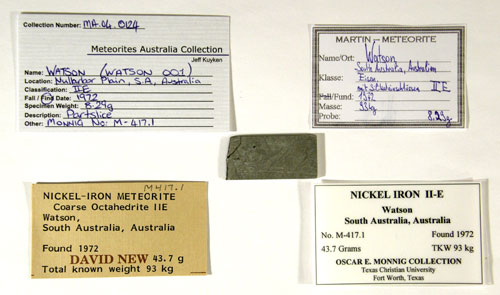


- Meteorites For Sale - Found A Meteorite? - Monthly Favourite - Meteorite Information - Classification List - Meteorite Collection - Media Centre - Home - Search - Site Map - Contact |
|
Watson (IIE) - 8.29g Partslice with Dendritic Melt Pockets The Watson meteorite was discovered near Watson on the Nullarbor Plain in South Australia, Australia during 1972. A single mass weighing 93kg was found which was classified as a IIE iron meteorite. During later slicing in 1990, a silicate inclusion was found in the meteorite. In fact it is the largest single silicate (stony) rock mass in any iron meteorite. It was found after study of this silicate, that it has a composition that matches the H-chondrites minus the usual metal and troilite content. It was also found that the oxygen isotope composition matches the IIE iron meteorites but also lies along the oxygen isotope fractionation line with the H-chondrites. It is thought that the Watson silicate was an H-chondrite which was engulfed by metal and melted at temperatures higher than 1550oC in a relatively closed system at or just below the asteroid surface. Metal and sulfide from the silicate that were incapable of being mixed were incorporated into the surrounding metal host. This helps to explain the difference in metal and troilite content between the silicate and normal H-chondrites. Around 8 million years after the above melting event, a shock event took place which liberated the Watson material from the asteroid parent body. This time frame also matches the peak frequency of exposure ages of the H-chondrites which helps further link them with the IIE irons. This shock event also caused some severe metal distortion and some localised melt pockets of Schreibersite/metal. In fact, along with the large silicate inclusion, one of the most interesting and distinctive features of the Watson meteorite is the presence of numerous dendritic melt pockets which have never before been encountered in such a large volume of metal. The photographs below show two distinct Schreibersite inclusions; one of which is of the dark variety. This darker inclusion is an example of one of the dendritic metal pockets where the Widmanstätten pattern almost appears to swirl towards it. The 8.29g partslice below has an interesting origin and provenance which is listed as: Oscar E. Monnig Collection (Texas Christian University) - David New - Al Mitterling - Andrzej S. Pilski - Martin Altmann - and is now part of the Meteorites Australia Collection (MA.04.0124).
Back to 'The Unusual Meteorites Features Page' menu...
|
%208.29g.jpg)


